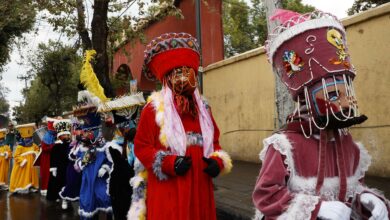Cornejo resurrecting Nijinsky ballet in Argentina

By Concepcion M. Moreno
Buenos Aires, Nov 8 (EFE).- Like the phoenix rising from the ashes, a ballet created in Argentina more than a century ago is being brought to the stage to rescue the “last inspiration” of legendary dancer Vaslav Nijinsky.
Argentina’s Herman Cornejo, the main dancer for the American Ballet Theatre (ABT) for the past 20 years, is excited to explain his first production – “Anima animal” – the idea for which arose during the coronavirus pandemic starting with his research into “Caapora,” created by Ricardo Guiraldes and Alfredo Gonzalez Garaño in 1915 for the iconic Russian dancer of Polish origin but which was never produced.
“(Nijinsky), after getting the inspiration and wanting to create this work, got sick and left the stage and disappeared. So, for me, being able to bring to the stage his last inspiration is very special. And, obviously, as far as I’m concerned it must be staged in Argentina,” the celebrated dancer said.
Cornejo, born in Villa Mercedes, Argentina, welcomed EFE to the Teatro Colon in Buenos Aires during rehearsals for the ballet “Romeo and Juliet,” which will be performed on Sunday and in which he dances with ABT ballerina Isabella Boylston in two of the five scheduled showings through Saturday, Nov. 12.
Few know that Nijinsky made a tour of Argentina and Uruguay in 1917, and even fewer are aware that on that trip two Argentine writers “gifted” him with their work and that he was “very motivated” to perform it, so much so that “he hired (Igor) Stravinsky to compose the music,” Cornejo said.
His schizophrenia diagnosis and retirement from the stage in 1919 brought the project to an end, however, and for more than a century it remained forgotten, a situation the Argentine dancer called “unbelievable.”
“I’ve spoke with many who understand it, and above all (understand) Nijinsky. One of the greatest is John Neumeier, choreographer and director of the Hamburg Ballet. Another person is the assistant director of the ABT, Clinton Luckett, and they know a great deal about Nijinsky. They have all his books and nobody knew that (he) was going to do a work here in Argentina. And the most striking thing is that it was his last inspiration,” Cornejo said.
The guarani legend of the phoenix that rises from the ashes and becomes the urutau bird – which is loaded with “spirituality” and “connection to the earth, the universe and the stars” – is part of a romantic story and has the urutau bird as its central figure, a bird that can barely see and has a call similar to a sob.
The culmination of “Anima animal” is Cornejo’s transformation into the urutau, which – he said – “is a bit of homage to Nijinsky,” given that, as he himself wrote, “I felt that I was transformed into light” by the Argentines’ ballet.
“When a star dies and falls to earth, a human being is born and his mission on earth is to purify his soul to once again become a being of light. And that is when we invoke Nijinsky in the legend within the legend to conclude the work,” he said.
With choreography by Anabella Tuliano, dancing by the members of the Grupo Cadabra, with Cornejo in the starring role, and music by the classical composer Noelia Escalzo and DJ Uji, the world premiere for the work will be Dec. 2 at the Teatro del Bicentenario de San Juan in western Argentina.
“Oh, it fills me with emotion to think that I looked all over the world and what attracted me were the personalities here, in Argentina,” said Cornejo, who has lived in New York for more than 25 years, but considers his “roots to be Argentine.”
He began dancing at age 8 and by the time he was 14 he entered the Ballet Argentino of Julio Bocca, who had seen in him at age 16 a kind of successor. At that early age, Cornejo had become the youngest winner of the Moscow Competition, one of the world’s most prestigious dance events, which Bocca himself had won 12 years before in 1985.
“Julio is world-renowned and for me he’s a key person in my development as a professional dancer. It was he who gave me a hand and took me out of my studies to put me up on stage,” said Cornejo, who admitted that he was able to realize his “dream” when he joined ABT with Bocca’s “discipline,” saying that “Talent is needed but the day to day work is fundamental.”
Due to his height and jumping ability, he has been compared with Mikhail Baryshnikov, which he said is “very nice,” although he added that “It’s very difficult to compare artists, to compare painters.”
Nevertheless, he takes that comparison with “a bit of responsibility” because “what one does is going to have consequences up and down the stage,” although he smiled upon being told he was a “reference figure” in dance, saying that “For me, it’s Julio.”
After surviving a coma as a baby “when they disconnected the machine,” he said that that and other health obstacles only made him “stronger.”
Thus, Cornejo can be said to resemble the phoenix, explaining that he, too, rose from the ashes. And now, he is shape-changing into the urutau out of his love for Nijinsky.
EFE cmm/rgm/rrt/bp





